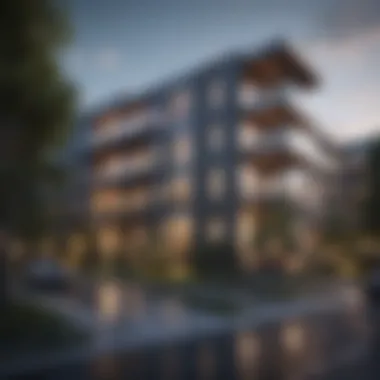Understanding Private Owned Apartment Complexes


Intro
Private owned apartment complexes have become increasingly relevant in today's real estate landscape. These establishments not only provide housing but also contribute to urban development and community living. Understanding their structure and implications requires exploration of various facets such as management practices, ownership models, and community engagement.
This article endeavors to unveil the intricacies of private owned apartment complexes, discussing their operational framework and what makes them appealing to both owners and tenants. It is essential to delve into how these complexes differ from traditional housing options and what advantages they offer in urban settings.
Ultimately, a thorough insight into these living spaces can illuminate the potential opportunities and considerations for those contemplating investments or residency in such environments.
Prelude to Private Owned Apartment Complexes
Private owned apartment complexes represent a significant segment of the housing market. Their structure and management differ from typical residential options, adding complexity and appeal. Understanding these complexes is essential for potential tenants and investors alike.
These properties can offer unique benefits, such as specialized amenities, enhanced security, and tailored services. The existence of private ownership leads to diverse offerings that cater to various lifestyles. Investors may find opportunities due to growing urban populations and increasing demand for rental properties. Additionally, this understanding allows for informed decisions in a fluctuating market.
Definition and Characteristics
Private owned apartment complexes are typically multi-family buildings owned by individuals or corporations. They differ from public housing or government-subsidized models in their operational structure. Key characteristics often include:
- Ownership Structure: These complexes are owned by private entities, which could be individuals or business firms.
- Amenities: Many of these properties feature various amenities such as fitness centers, swimming pools, and communal spaces.
- Management: The management is usually handled by professionals or property management companies, ensuring maintenance and tenant relations are prioritized.
Additionally, they tend to foster communities that enhance resident experiences through activities and social gatherings.
Historical Context and Development
The concept of private housing can be traced back to early urbanization events. As cities expanded, the demand for housing grew. Initially, single-family homes dominated, but the increase in population density led to a rise in multi-family dwellings.
In the 20th century, private ownership gained traction with improvements in building technology and economic conditions. This trend accelerated with post-war urbanization and the expansion of suburbs in the latter half of the century. Today, private owned apartment complexes are often seen as a necessary response to the housing shortages present in many urban areas.
Understanding this history is vital. It provides insight into current market dynamics and the continuous evolution of housing structures. For those in the real estate sector, knowing these factors informs investment strategies and community planning.
Ownership Structures
Ownership structures in private owned apartment complexes play a vital role in determining both the management style and the investment potential of these properties. Understanding these structures enables prospective tenants and investors to make informed decisions. They reveal how ownership affects everything from building maintenance to tenant relations.
The classification of ownership can greatly influence residents’ experiences and the financial stability of the complex. The presence of either individual owners or corporate structures can provide different levels of amenities, oversight, and community engagement.
Types of Ownership: Individual versus Corporate
In private owned apartment complexes, ownership can predominantly be categorized into two types: individual ownership and corporate ownership.
- Individual Ownership: In this model, a single person or a group of individuals own separate units within the complex. Each owner is responsible for their own properties, typically sharing common areas and facilities. This structure might facilitate a more community-oriented living experience. Individual owners may personally manage their apartments, leading to varying levels of care and attention. However, issues can arise when it comes to collectively addressing maintenance or community rules, as decision-making could become difficult due to differing interests.
- Corporate Ownership: Alternatively, when a corporation owns the entire complex, management tends to be more centralized. This often results in standardized policies and services being applied throughout the property. Corporate ownership can lead to enhanced professionalism in the management of amenities and security. On the other hand, this structure can lack the personal touch that some residents seek.
"The choice between individual and corporate ownership can greatly influence the dynamic and quality of life in a private apartment complex."
Understanding these distinctions is crucial for both investors and potential residents. Individual ownership might appeal to those seeking a sense of community involvement, while corporate ownership may attract those desiring more professional management and potentially more stable property values.
Investment Opportunities
When it comes to investment opportunities, understanding ownership structures can lead to informed decisions for investors. Investing in private owned apartment complexes offers various avenues, each shaped by how ownership is structured.
- Individual Unit Investment: Investors can purchase individual units within a complex. This type of investment allows for potential rental income alongside property appreciation. Investors might benefit from the community feel of individual ownership; however, they must be prepared for variability in tenant relations and upkeep, as these factors can lead to distinct market performance.
- Corporate Investment: A corporate structure might allow investors to buy shares in a larger operation. This method often offers a more diversified approach to real estate investment without the direct management responsibilities. Participating in such investments can yield consistent returns, especially if the corporation maintains effective property management.
- REITs: Real Estate Investment Trusts provide another way to invest in private owned apartment complexes. These trusts hold and manage portfolios of real estate, allowing smaller investors to benefit from income generated by a collection of properties that they wouldn't be able to afford individually.
Benefits of Residing in Private Apartment Complexes
The importance of understanding the benefits of residing in private apartment complexes is crucial for prospective tenants and investors alike. As urban living continues to evolve, these complexes offer unique advantages that appeal to a wide range of individuals. The features and amenities found in private complexes often exceed those of standard rental options. Moreover, considerations around security and community can significantly influence the quality of life for residents.


Luxury Amenities and Features
One of the primary draws of private owned apartment complexes is the availability of luxury amenities and features that enhance daily living experiences. Many of these facilities include high-end fitness centers, swimming pools, rooftop terraces, and communal lounges. Such amenities can make life more enjoyable and convenient. For instance, residents may appreciate having a gym on site, saving travel time to other facilities.
Additional services, such as concierge support, package handling, and maintenance requests, are often tailored to meet the needs of tenants. This type of management ensures that issues are addressed swiftly, creating a seamless living environment. Modern private complexes may also integrate smart living technology, allowing residents to control essential functions like lighting and temperature through their smartphones.
Enhanced Security and Privacy
Enhanced security and privacy in private apartment complexes further contribute to their desirability. Many complexes employ advanced security measures, such as gated entrances, surveillance systems, and secure access controls. Such features can increase peace of mind for residents. For those living alone or looking for a safe community, these measures are paramount.
Additionally, the layout of these complexes often fosters a greater sense of privacy. Unlike traditional apartment buildings, private complexes may offer individual balconies and spacious floor plans that reduce noise levels between units.
The combination of luxury amenities and enhanced security makes private apartment complexes an attractive choice for individuals seeking a comfortable and secure living environment. Residents can enjoy modern conveniences while feeling safe and part of a community.
"Living in a private apartment complex means accessing more than just a home; it's about enjoying a lifestyle filled with comfort and security."
Ultimately, for real estate enthusiasts, these benefits present a compelling case for considering private owned apartment complexes for both living and investment purposes.
Management Practices in Private Apartment Complexes
Effective management is a cornerstone of private owned apartment complexes. It encompasses a range of practices that directly influence the quality of life for residents and the overall functionality of the complex. From maintenance to tenant relations, the level of management can significantly affect both tenant satisfaction and property value.
Role of Property Managers
Property managers act as the lynchpin between owners and tenants. They ensure that properties are well-maintained and that residents adhere to community guidelines. Their responsibilities include overseeing maintenance requests, managing rental agreements, and devising budgets. A skilled property manager can enhance the living experience by fostering a responsive environment where tenants feel heard.
The role is not limited to operational tasks. Property managers also handle tenant complaints and disputes effectively, which is essential for maintaining a harmonious community atmosphere. Their ability to resolve issues promptly can prevent minor conflicts from escalating, thereby promoting longer tenancies and reducing turnover rates.
Moreover, property managers often facilitate a range of services that enhance tenant experience. This can range from organizing community events to addressing security concerns. Their presence helps in establishing a strong community identity, which can be crucial in fostering a sense of belonging among residents.
Community Engagement and Lifestyle Programming
Community engagement plays a pivotal role in the appeal of private owned apartment complexes. Engaging residents in activities fosters a shared sense of purpose and connection. Lifestyle programming often includes various events, such as fitness classes, movie nights, or seasonal celebrations.
These activities do not merely serve as entertainment; they also build relationships among residents. Positive social interactions can improve overall satisfaction and make a complex feel like a true home. A vibrant community can deter crime and encourage residents to stay longer, benefiting property owners as well.
In addition to traditional events, property managers can implement programs that respond to the interests of the tenants. For example, eco-friendly initiatives can attract environmentally conscious individuals.
Engaging residents also extends to channels of communication. Online forums or community boards can serve as platforms for sharing ideas and feedback. This inclusive approach ensures that tenant voices are heard and considered in decision-making.
In summary, effective management practices in private apartment complexes foster a conducive living environment. From the proactive role of property managers to the implementation of community programs, every aspect contributes to the tenants’ wellbeing and longevity in their homes.
Through these practices, private owned apartment complexes can distinguish themselves in the competitive housing market.
Regulatory Framework and Compliance
The regulatory framework surrounding private owned apartment complexes is critical in guiding their operations, ensuring safety, and maintaining neighborhood standards. This section highlights specific elements of regulations that are beneficial to both owners and tenants, and key considerations that must be taken into account.
Local Laws and Ordinances
Local laws and ordinances are foundational in shaping how private apartment complexes function. Each municipality has distinct regulations that dictate zoning laws, property use requirements, and even tenant rights. These laws can influence the types of services and amenities that apartment complexes can offer.
For instance, a community might have restrictions on the height of new buildings or on how close they can be to roadways. These regulations help to preserve the character of neighborhoods and ensure infrastructure can handle increased populations.
Also, local laws often involve inspection requirements. Regular inspections ensure that buildings meet safety standards. This can cover structural integrity, heating, cooling systems, and water supply issues. Failure to comply with such ordinances can lead to fines or even the revocation of occupancy permits.


Health and Safety Regulations
Health and safety regulations are another significant aspect in the management of private owned apartment complexes. These regulations center on maintaining a safe living environment for residents. Compliance with health codes may include proper sanitation of communal areas, management of waste, and vector control measures to prevent infestations.
Furthermore, safety regulations often mandate the installation of smoke detectors, fire alarms, and emergency exits. These systems protect tenants in emergency scenarios and are crucial in upholding the responsibility of property managers.
Additionally, certain health and safety regulations dictate how to respond to natural disasters. For example, regulations may require specific building materials in earthquake-prone areas. Adhering to these guidelines not only protects residents but also guides property investments.
Regulatory compliance is not just a legal obligation; it is integral to fostering tenant trust and maintaining property value.
The Role of Private Owned Apartment Complexes in Urban Development
Private owned apartment complexes play a pivotal role in shaping urban environments. As cities expand, the demand for housing rises. This creates a complex interplay between housing supply and demand, which these complexes help to balance. They cater to a variety of demographics, providing options that meet the needs of different groups. From young professionals to families, the variety in unit sizes and configurations is significant.
Moreover, these complexes often include amenities that enhance the living experience. Features such as gyms, pools, and outdoor spaces are designed to attract tenants. This investment in amenities is not just about luxury; it is about addressing the lifestyle expectations of modern urban dwellers, thus increasing the overall appeal of urban living.
Impact on Housing Supply and Demand
The relationship between private owned apartment complexes and housing supply is critical. These complexes increase the number of available housing units in urban areas. They fill gaps in the housing market, alleviating pressure on existing supply. In areas with a growing population, new complexes can quickly address housing shortages.
In addition, they can stabilize rental prices. Increased supply typically leads to more competitive pricing, which benefits tenants significantly. Developers often conduct market studies to ensure they are meeting local demand effectively, adjusting designs and unit sizes as needed. This responsiveness to market conditions is essential for creating successful residential communities.
Contribution to Neighborhood Revitalization
Private owned apartment complexes often spur revitalization in underdeveloped neighborhoods. Their construction can lead to an influx of residents, which in turn attracts businesses and amenities to the area. As more people move into a neighborhood, the local economy can see improved performance. Retailers, restaurants, and services often follow residents, creating a vibrant community atmosphere.
Furthermore, these complexes can enhance local infrastructure. Improved roads, enhanced public transport, and upgraded public spaces often accompany new developments. Property developers may invest in neighborhood improvement projects as part of their development plans, making the area more livable. Such improvements contribute to raising property values, benefiting both property owners and the municipality.
Potential Challenges and Considerations
Understanding potential challenges and considerations related to private owned apartment complexes is crucial for both existing owners and prospective tenants. These factors can influence decision-making processes and relate directly to the economic and social framework of apartment living. Addressing market fluctuations and tenant relations provides clarity on the matters that can significantly affect the stability and growth of these complexes.
Market Fluctuations and Economic Impact
Market fluctuations can have a profound impact on private owned apartment complexes. The real estate market is often volatile, influenced by various factors such as interest rates, economic growth, and local demand for housing. Significant shifts in the economy can result in decreased property values and changing rental rates.
For instance, during an economic downturn, the demand for rental units may decline, leading to higher vacancy rates. Owners of apartment complexes might find it hard to maintain consistent cash flow. This financial instability can result in budget cuts on maintenance and staff, affecting the overall living experience for tenants.
In contrast, an economic upturn often brings increased demand for housing. This can lead to rising rents and potentially benefits owners as property values appreciate and occupancy rates improve. However, increased competition in desirable locations could push tenants towards newer or more attractive complexes. Adapting to these market trends is essential for owners to remain competitive.
"Market dynamics necessitate a keen awareness and ability to adapt for owners of apartment complexes to ensure sustained profitability."
Tenant Relations and Community Conflicts
Effective tenant relations are vital for the harmonious living environment in private owned apartment complexes. Community conflicts can arise from various issues, including noise complaints, differing lifestyles, or disagreements about communal space usage. These conflicts can tarnish the reputation of the complex and lead to tenant turnover.
To mitigate these conflicts, establishing clear communication channels is crucial. Property management must be accessible and responsive to tenant needs and concerns. Regular community meetings can help address issues proactively and foster a sense of belonging among the residents.
Furthermore, promoting community engagement through social events or activities can enhance tenant satisfaction and cooperation. When tenants feel invested in their community, they are less likely to engage in behaviors that may lead to disputes. Positive tenant relations not only improve the quality of life for residents but also support a stable income for property owners.
Balancing these elements—economic factors and tenant harmony—is essential for anyone involved in private owned apartment complexes. Understanding the intricacies of these challenges can lead to informed decisions that promote both tenant satisfaction and business viability.
Trends Influencing Private Apartment Complexes
In the context of private owned apartment complexes, various trends are reshaping how these living spaces are designed, managed, and marketed. Understanding these trends is significant for both current and prospective residents, as well as investors and property managers. With the evolving preferences of tenants and ongoing advancements in technology, private apartment complexes are adapting to meet new demands. This section will discuss two major trends: sustainability practices and technological integrations, highlighting their implications, benefits, and considerations.


Sustainability Practices
Sustainability has become a focal point not just in architecture but also in the operations of private owned apartment complexes. Many tenants today prioritize living in eco-friendly environments. This shift is fueled by a growing awareness of environmental issues. Implementing sustainable practices can attract a demographic that values responsible resource use and environmental stewardship.
Private apartment complexes are increasingly integrating green building standards. Features such as energy-efficient appliances, rainwater harvesting systems, and solar panels are being adopted more widely. These adjustments lower utility costs and enhance residents’ comfort.
Key benefits of sustainability practices include:
- Cost Savings: Efficient systems reduce long-term operational costs.
- Market Appeal: Eco-friendly buildings attract environmentally conscious tenants.
- Regulatory Compliance: Keeping up with local laws regarding environmental standards.
However, challenges exist. The initial investment in green technologies can be high. Complexes must weigh upfront costs against long-term gains. Moreover, educating residents about sustainable practices is crucial to maximizing these benefits.
Technological Integrations and Smart Living
The advent of smart technology has significantly reshaped the landscape of private apartment complexes. Technological integrations enhance living experiences and streamline management processes. Today, features like smart home systems, automated security, and energy management apps have become common.
These technologies provide residents with greater control over their environment. For instance, smart thermostats allow individual climate control, optimizing comfort and energy consumption. Automated security systems enhance safety, ensuring peace of mind for residents.
The influence of technology can be summarized into several important aspects:
- Enhanced Convenience: Seamless navigation of daily activities and tasks.
- Improved Security: Real-time monitoring and alerts increase residents' safety.
- Data-Driven Management: Property managers can optimize operations based on usage data.
Potential drawbacks include concerns about data privacy and the costs of maintaining these advanced systems. Those managing the properties need thorough plans to address these issues, ensuring a balance between innovation and security.
Future of Private Owned Apartment Complexes
The future landscape of private owned apartment complexes is pivotal for urban housing dynamics and real estate markets. As cities continue to evolve, these complexes will adapt in various ways. The changing preferences of both consumers and developers will shape how these living spaces function, looking at sustainability, technology integration, and architectural designs.
Emerging Architectural Trends
Architecture in private owned apartment complexes is shifting significantly. New designs prioritize not only aesthetics but also functionality and sustainability. Key trends include:
- Sustainable Materials: Developers are now choosing eco-friendly materials. This reflects a growing awareness of environmental impact. Using recycled and sustainably sourced materials reduces carbon footprints associated with construction.
- Mixed-Use Developments: Increasingly, complexes incorporate residential, commercial, and recreational spaces. This strategy fosters community interaction and provides residents with immediate access to services and amenities.
- Flexible Spaces: Architects are designing apartments with flexibility in mind. Open floor plans and adaptable rooms cater to diverse lifestyles and needs. The goal is for residents to easily modify layout according to personal preferences.
- Biophilic Design: This concept integrates nature into architectural surroundings. Features such as green roofs, natural light, and indoor plants not only enhance visual appeal but also improve mental health and well-being.
Emerging architecture trends will continue to mold urban centers, making private owned apartment complexes not merely residences but vibrant living environments.
Evolving Consumer Preferences
Consumer preferences in housing are constantly evolving. Understanding these changes is essential for those involved in real estate. Key elements affecting consumer choices include:
- Demand for Sustainability: Residents are increasingly prioritizing eco-friendly living. They seek apartments featuring energy-efficient appliances and sustainable living practices. This has prompted developers to adapt and create more green spaces.
- Technological Integration: Smart technology is in high demand. Consumers prefer apartments equipped with smart home features like automated lighting, heating control, and security systems. These technologies provide convenience and enhance overall quality of life.
- Focus on Community: More residents value community engagement and a sense of belonging. They are inclined to choose complexes that offer social events, shared spaces, and active community engagement initiatives.
- Health and Wellness: Today’s consumers often seek apartments that promote well-being. Features that support mental and physical health, such as fitness areas, yoga studios, and outdoor spaces, are increasingly sought after.
The evolving preferences are highlighting the importance of adaptability in real estate development. As these trends unfold, they will define the future of private owned apartment complexes, ensuring they meet increasingly diverse needs.
Culmination
The significance of private owned apartment complexes can not be understated in today's urban landscape. This article has explored various aspects of these living spaces, from their ownership structures to the benefits they provide to residents. Understanding these elements is essential for potential tenants and owners alike.
Private apartment complexes often cater to diverse lifestyles, offering amenities and living arrangements that can be hard to find in other housing options. These buildings often create a sense of community amongst residents, which can enhance the living experience.
Recap of Key Insights
In summary, the analysis presented highlights several key points:
- Ownership Structures: Different models of ownership influence how these complexes operate and are perceived in the market.
- Benefits of Living: Residents can enjoy luxurious amenities and enhanced security, which adds to their quality of life.
- Management Practices: Effective property management plays a vital role in maintaining the standard of living and fostering community engagement.
- Regulatory Compliance: Awareness of local laws ensures safety and adherence to community standards.
This compilation of insights is critical for those navigating the landscape of private owned apartments, as informed decisions can lead to better living conditions and investment opportunities.
Call for Further Research
Although this article covers many aspects of private owned apartment complexes, further research is needed to delve into areas such as:
- Impact of Economic Conditions: Understanding how market fluctuations affect these housing options can give clarity to both landlords and tenants.
- Technological Advances: As smart living evolves, ongoing studies into how technology shapes residential experiences will provide beneficial insights.
- Sustainability Initiatives: With growing awareness of environmental responsibilities, examining sustainability practices within these complexes can guide future developments.







